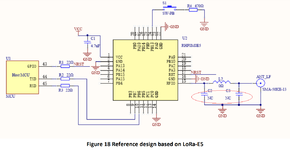5spdvl
Newbie
Hello all,
I've designed a portable LoRa module, operated by an ESP8266 module, powered by a lipo and recharged over USB-C. Attached is the EasyEDA schematic.
I've spent a few years tinkering with the major components of this design as discrete units (like, a ESP8266 NodeMCU dev board, rather than the module itself), but I am really wanting to be able to design PCBs from scratch. The attached design was created using the datasheets for each component, and my understanding of electronics.
I am a hobbyist, so there are no doubt errors or odd choices. Seeking feedback to improve/avoid a lipo overcharge situation
Thankyou.

I've designed a portable LoRa module, operated by an ESP8266 module, powered by a lipo and recharged over USB-C. Attached is the EasyEDA schematic.
I've spent a few years tinkering with the major components of this design as discrete units (like, a ESP8266 NodeMCU dev board, rather than the module itself), but I am really wanting to be able to design PCBs from scratch. The attached design was created using the datasheets for each component, and my understanding of electronics.
I am a hobbyist, so there are no doubt errors or odd choices. Seeking feedback to improve/avoid a lipo overcharge situation
Thankyou.
